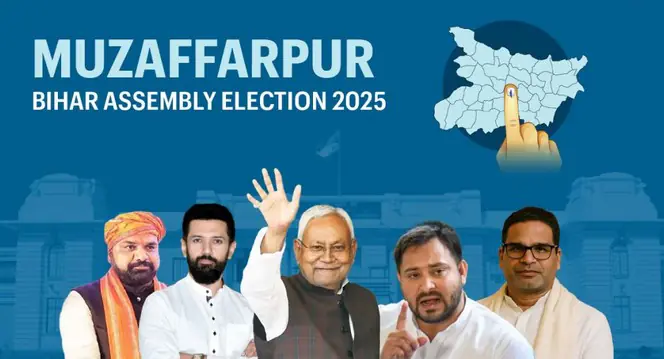
With the 2025 Bihar Assembly Elections underway, Muzaffarpur’s eleven assembly constituencies have come under the spotlight, presenting a fascinating blend of legacy battles, caste equations, party rebellions, and the influence of local issues. The region’s political landscape stretches from historical icons like George Fernandes and martyr Jubba Sahni to contemporary contests defined by social divides and grassroot calculations.
Shifting Ground: From Slogans to Strategy
The elections in Muzaffarpur once echoed with bold slogans and ideological campaigns, as seen post-Emergency with historic calls like “Jail ka tala tootega, hamara George jeetega!” In 2025, however, the fight revolves less around grand narratives and more around local legacy, caste arithmetic, and internal party equations.
Gaighat: Focus on Legacy and Rebellion
Surrounded by the Bagmati and Budhi Gandak rivers, Gaighat stands at the centre of attention due to open rebellion within NDA ranks this cycle. The contest features Komal Singh of JDU, daughter of MLC Dinesh Singh, against sitting RJD MLA Niranjan Rai. Rajputs and Yadavs comprise the primary vote banks, but Ashok Singh of Jan Suraj seeks to make it a triangular contest. Additionally, former JDU MLA Maheshwar Yadav and his son Prabhat Kiran have crossed over to RJD, impacting strategic calculations. Voters discuss split votes and community loyalties, while local concerns—such as the deadly 2023 boat accident and ongoing bridge construction—linger.
Sakra: Reserved and Resilient
In Sakra, campaign activity is buzzing amidst the renovation of the historic Tirhut canal. The seat, currently held by JDU’s Ashok Chaudhary, is now contested by his son Aditya Kumar with Congress’s Umesh Ram as the other major contender. Rajput, Sahni, and Muslim voters dominate Sakra’s narrative, where economic concerns intertwine with daily life and women’s empowerment, evidenced by stories of entrepreneurship and evolving local businesses.
Meenapur: Straight Fights and Social Concerns
Meenapur, marked by Sahni, Yadav, and Kushwaha population blocks, pits RJD’s Munna Yadav against JDU’s Ajay Kumar, son of former MLA Dinesh Kushwaha. Here, being a “society’s candidate” does not guarantee victory, as practical issues like pensions, infrastructure, and power supply shape voter sentiment.
Muzaffarpur: Legacy and Change
The city constituency, the only Congress stronghold in North Bihar, features a high-profile contest between five-time Congress MLA Vijendra Chaudhary and BJP’s first-time face Ranjan Kumar. Other contenders include Dr. A.K. Das—an independent influencer—and Sanjay Kejriwal of Jan Suraj. Voters discuss internal sabotage (bhitarghaat) and the shifting impact of high-profile campaign rallies. Development, women’s issues, and public neglect are central themes.
Bochaha: Family, Caste, and Performance
Bochaha sees RJD’s Amar Paswan, son of former MLA Musafir Paswan, challenge LJP (R)’s Baby Kumari, with previous contenders and coalitions continuing to shape the outcome. Discussions centre around family division, economic benefit schemes, and caste dynamics, especially among Kalwar, Vaishya, and other communities.
Kanti: Changed Faces, Community Calculus
Both JDU’s Ajit Kumar and RJD’s Israil Mansuri, former ministers, vie for the influential Kanti seat. With Bhumihar and Muslim voters holding sway, the race also features Jan Suraj’s Sudarshan Mishra. Business, electricity, and candidate trust shape the contest, with community leaders cautioning against split votes and advocating informed choices.
Aurai: Battered by Floods, Awaiting Bridges
Aurai, fraught with flood legacy and waiting for vital bridges, saw BJP’s veteran Ram Surat Rai lose his ticket to Rameshwar Kumar, while Congress’s former MP Ajay Nishad’s wife, Rama Nishad, now runs as BJP’s candidate. The seat is further animated by Mahagathbandhan’s Bhogendra Sahni of VIP and Jan Suraj’s Bablu Singh. Government performance, flood management, and caste politics rule local debates.
Paroo: Farmers, Factions, and Fluid Loyalties
In Paroo, once BJP’s bastion, Independent candidate Ashok Kumar Singh battles Ralomo’s Madan Chaudhary and RJD’s Shankar Prasad. Farmer concerns and issues of water management, along with discussions about historic leaders like Karpoori Thakur, dominate local discourse.
Sahebganj, Baruraj, and More: Caste and Coalition
Sahebganj’s mix of Rajput, Yadav, Vaishya, and Muslim voters features BJP’s Raj Kumar Singh and RJD’s Prithvi Nath Rai as key contenders, alongside Jan Suraj’s Thakur Harikishore Singh. Voters here, as elsewhere, consider both party performance and the possibility of change. Baruraj’s fate is tied to the closure of Motipur sugar mill and the face-off between BJP’s Arun Kumar Singh and VIP’s Rakesh Kumar. Alongside, local voices wrestle with communal narratives, development challenges, and the authenticity of election promises.
Who Holds Which Seat?
| Constituency | Incumbent Party | Incumbent MLA |
|---|---|---|
| Gaighat | RJD | Niranjan Rai |
| Aurai | BJP | Ram Surat Rai |
| Meenapur | RJD | Rajiv Kumar |
| Bochaha (SC) | RJD | Amar Paswan |
| Sakra (SC) | JDU | Ashok Chaudhary |
| Kudhni | BJP | Kedar Gupta |
| Muzaffarpur | Congress | Vijendra Chaudhary |
| Kanti | RJD | Israil Mansuri |
| Baruraj | BJP | Arun Kumar Singh |
| Sahebganj | BJP | Raj Kumar Singh |
| Paroo | BJP | Ashok Kumar Singh |
Bihar politics in 2025
Muzaffarpur’s eleven constituencies vividly encapsulate the complexity and intensity of Bihar politics in 2025. Here, voter choice is shaped not just by party allegiance but by a matrix of caste, legacy, local issues, rebel candidates, and the search for meaningful development. As contestants vie for power, it is the dynamic interplay of these factors that will decide who carries the region’s mantle in the next assembly. For the people of Muzaffarpur, the election is a test—of memory, hope, resilience, and the promise of progress in the heart of Bihar.
